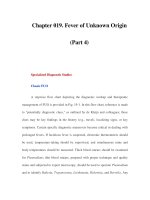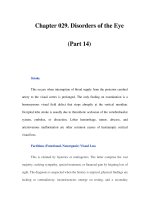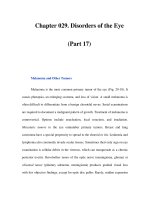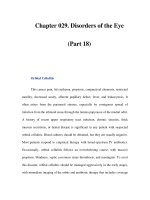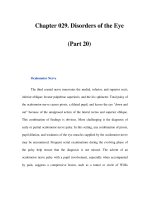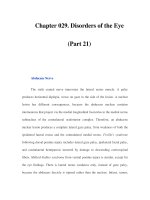Chapter 083. Cancer of the Skin (Part 4) pot
Bạn đang xem bản rút gọn của tài liệu. Xem và tải ngay bản đầy đủ của tài liệu tại đây (43 KB, 5 trang )
Chapter 083. Cancer of the Skin
(Part 4)
Management
The entire cutaneous surface, including the scalp and mucous membranes,
should be examined in each patient. Bright room illumination is important, and a
7x to 10x hand lens is helpful for evaluating variation in pigment pattern. A
history of relevant risk factors should be elicited. Any suspicious lesions should be
biopsied, evaluated by a specialist, or recorded by chart and/or photography for
follow-up. Examination of the lymph nodes and palpation of the abdominal
viscera are part of the staging examination for suspected melanoma. The patient
should be advised to have other family members screened if either melanoma or
clinically atypical moles (dysplastic nevi) are present. The detection of early
melanoma in relatives has been reported.
Melanoma prevention is based on protection from the sun. Routine use of a
broad spectrum UV-A/UV-B sunblock with sun protection factor ≥15, use of
protective clothing, and avoiding intense midday ultraviolet exposure should be
recommended. The patient should be educated in the clinical features of melanoma
and advised to report any growth or other change in a pigmented lesion. Patient
education brochures are available from the American Cancer Society, the
American Academy of Dermatology, the National Cancer Institute, and the Skin
Cancer Foundation. Self-examination at 6- to 8-week intervals may enhance the
likelihood of detecting change. The importance of routine follow-up visits for
melanoma patients and patients with clinically atypical moles (dysplastic nevi)
should be emphasized, as these visits may facilitate early detection of new primary
tumors.
Precursor Lesions
Clinically atypical moles, also termed dysplastic nevi, occur in certain
families affected by melanoma. In some families, melanomas occur nearly
exclusively in the individuals with dysplastic nevi. In other families, the nevi may
not be present in all individuals with an increased risk of melanoma. The
melanomas may arise in clinically atypical moles or in normal skin (in the latter
situation the moles act as markers of increased risk). Individuals with clinically
atypical moles and a strong family history of melanoma have been reported to
have a >50% lifetime risk for developing melanoma. Table 83-4 lists the features
that are characteristic of clinically atypical moles and that differentiate them from
benign acquired nevi. The number of clinically atypical moles may vary from one
to several hundred. Clinically atypical moles usually differ from each other in
appearance. The borders are often hazy and indistinct, and the pigment pattern is
more highly varied than that in benign acquired nevi. Of the 90% of melanoma
patients whose disease is regarded as sporadic (i.e., who lack a family history of
melanoma), ~40% have clinically atypical moles, as compared with an estimated
5–10% of the population at large. Further studies to determine the background
frequency of clinically atypical moles are required, once greater unanimity exists
regarding their clinical and histopathologic features. The observation that sporadic
melanomas can arise in association with a clinically atypical mole makes this the
most important precursor for melanoma. Less frequent precursors include the giant
congenital melanocytic nevus. Congenital melanocytic nevi are present at birth or
appear in the neonatal period (tardive form). The giant melanocytic nevus, also
called the bathing trunk, cape, or garment nevus, is a rare malformation that
affects perhaps 1 in 30,000 to 1 in 100,000 individuals. These nevi are usually >20
cm in diameter and may cover more than half the body surface. Giant nevi often
occur in association with multiple small congenital nevi. The borders are sharp,
and hair may be present. The lesions are usually dark brown and may have darker
and lighter areas. Pigment is haphazardly displayed. The surface is smooth to
rugose or cerebriform and may vary from one portion of the lesion to another.
Table 83-
4 Clinical Features Distinguishing Atypical Moles from
Benign Acquired Nevi
Clinical
Feature
Clinically Atyp
ical
Moles
Benign Acquired Nevi
Color
Variable mixtures of tan,
brown, black, or red/pink within
a single nevus; nevi may look
very different from each other
Uniformly tan or brown
Shape
Irregular borders;
pigment may fade off into
surrounding skin; macu
lar
portion at the edge of the nevus
Round; sharp, clear-
cut
borders between the nevus and
the surrounding skin; may be
flat or elevated
Size
Usually >6 mm in
diameter; may be >10 mm;
occasionally <6 mm
Usually <6 mm in
diameter
Number Often very many
(>100),
but occasionally may be only
one
In a typical adult, 10 to
40 are scattered over the body;
perhaps 15% of patients have
no nevi
Location Sun-
exposed areas; the
back is the most common site,
but dysplastic nevi may also be
seen on the scalp, breast
s, and
buttocks
Generally on the sun-
exposed surfaces of the skin
above the waist; the scalp,
breasts, and buttocks are rarely
involved
Source: Modified from RJ Friedman et al: CA—
A Cancer J Clinicians
33(3):130, 1985.

